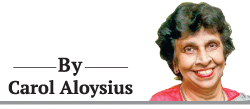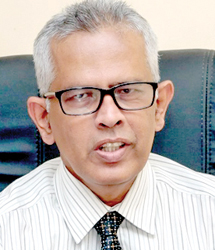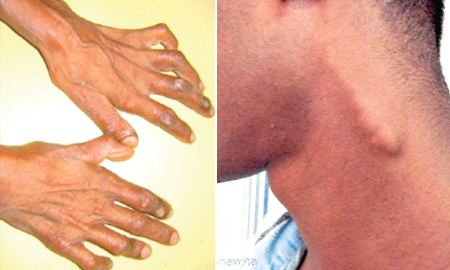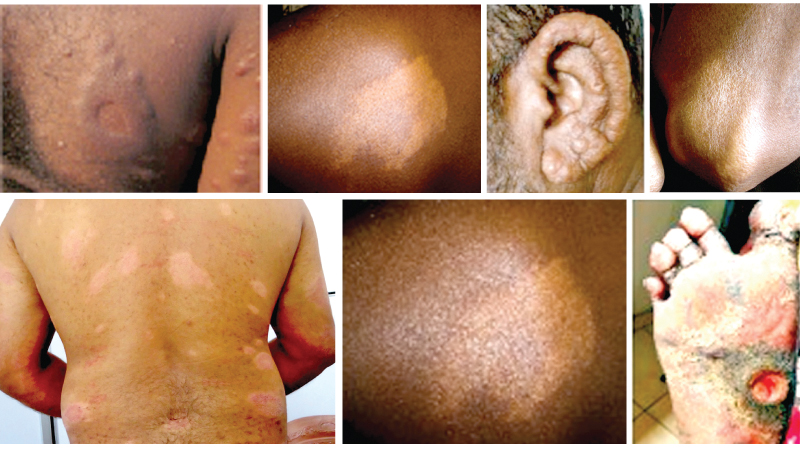
On World Leprosy Day which fell on January 28, skin specialists across the world convened to discuss a disease that remains shrouded in secrecy and misunderstanding despite persistent efforts by the Health Ministries.
The Sunday Observer sought the help of Consultant Community Physician, Anti Leprosy Campaign Dr. Prasad Ranaweera to find out the reasons preventing vulnerable persons from seeking early treatment and how they can be eliminated with medications prescribed taken correctly and a change in attitude by the Community to enable them to lead normal lives with dignity.
Excerpts.
Q: This year’s theme for World Leprosy Day is “Ending Stigma, Embracing Dignity.” Why was it chosen,and what is its message to patients with the disease in general?

Dr. Prasad Ranaweera
A. The main obstacle we face in the process of leprosy elimination is the stigma. Therefore, it is high time to end stigma and eliminate leprosy as it is just another communicable and curable disease.
Q: What is its specific significance to Sri Lankan patients?
A. To eliminate Leprosy from Sri Lanka, we have to identify all the leprosy patients in the country. For that our patients should come forward with their symptoms. To improve patients’ health-seeking behaviour stigma should be minimised. Our concept is: “We need a society who talks about leprosy. There is no need for a society where people hide due to stigma”
Q: How prevalent is the disease in Sri Lanka according to your latest data?
A. The total number of new leprosy cases in the year 2023 was 1550 with 173 of these being children. In 2002, the total number of leprosy patients detected was 1401 (Child cases 155). About 45 percent of the leprosy burden was from the Western Province and Batticaloa District. When we consider child leprosy cases, almost 50 percent of those last year were from 3 districts (Colombo, Gampaha and Batticaloa districts.)
Q: Do you see a change in the figures in the past few years?
A. Even though we see a reduction in new case detection rate, the rate of child cases is increasing. High rates of child cases indicate that the disease transmission is not interrupted. In Sri Lanka we have identified 83 Divisional Secretariats where transmission is continuing. We need more attention to control child leprosy in these DSDs.
Q: In a recent interview with the media you said that there was a spike in the number of cases. Where were these changes most observed region-wise and district-wise?
A. Even though we detect leprosy cases islandwide, usually leprosy is more common in Western Province and Batticaloa district. According to WHO indicators, Central and Uva Provinces have achieved leprosy elimination targets.
Q: Why were only some districts affected? What are the causes -weather changes, ignorance or lack of access to hospitals for patients resulting in delays for early detection and treatment?
A. Leprosy cases are detected islandwide. As mentioned earlier, it is more prevalent in some districts which can be attributed to the factors such as overcrowding, health care seeking behaviour of the population or logistic factors. Leprosy is more common in the Coastal belt in Western Province where population density is high.
Q: You also mentioned that 15 percent of the cases were among schoolchildren. How did this happen?
 A. The cut-off age for the definition of child Leprosy is 14. These children acquire leprosy from leprosy-positive patients who are not on treatment and live in close contact with the child. Increased number of child cases indicates the active transmission in the community.
A. The cut-off age for the definition of child Leprosy is 14. These children acquire leprosy from leprosy-positive patients who are not on treatment and live in close contact with the child. Increased number of child cases indicates the active transmission in the community.
Q: What are the symptoms that parents should look out for to find out if their child has leprosy?
A. * Hypopigmented anesthetic patches
* Nerve thickening
* Loss of sensation especially in hands and feet which will lead to injuries such as burns in hands, prick wounds in legs
Q: How is Leprosy diagnosed with a blood smear or an X ray?
A. Leprosy is a clinical diagnosis and the diagnosis is done by a consultant dermatologist.
There are no blood tests to confirm leprosy. A biopsy test can be used to support the clinical diagnosis if needed.
Q: Are the symptoms different in children and in adults? If so, in what way?
A. There are no differences in symptoms in adults and children.
Q: How is leprosy transmitted – by prolonged contact with a patient or is it airborne?
A. Leprosy is transmitted through respiratory droplets and there should be a prolonged contact for about 3 months with a leprosy patient who is not on treatment.
Q: Since many readers still don’t know the exact cause/s of Leprosy, could you educate them?
A. Leprosy is caused by a bacteria called Mycobacterium Leprae.
Q: Who can make a proper diagnosis?
A. A consultant dermatologist in a dermatology clinic in a government hospital will diagnose leprosy.
Q: Does a diagnosis require a hospital setting?
A. If you suspect that you have leprosy, you can visit the OPD of a government hospital where there is a dermatology clinic and from the OPD you will be referred to the dermatology clinic. Therefore the diagnosis can be made in a clinic setting and admission to a ward is not needed.
Q: If diagnosed early, is leprosy curable?
A. Leprosy is completely curable if detected early.
Q: What happens to the human body when afflicted with leprosy? Will it lower their immunity levels?
A. No such evidence. The incubation period of leprosy is 3-5 years. It may even be up to 20 years.
Q: What is the usual treatment procedure for a patient confirmed with the disease?
A. There are two types of Leprosy and the treatment regimens are different in each type.
*Multibacillary type- 12 months
* Paucibacillary type- 6 months
Q: Once treated and cured, can a patient get re–infected?
A. Reinfection is possible as the infection does not provide lifelong immunity. But it is not common.
Q: How long does it take for a person who has undergone treatment to be considered as non-infectious to others? Days? Weeks? Months?
A. Usually within the first few days (about 7 days) after treatment for leprosy, the disease is not transmitted.
Q: What happens to a victim if the condition is untreated for some reason?
A. As leprosy affects the peripheral nervous system in addition to the skin, untreated leprosy carries a risk of nerve damage which can lead to permanent disabilities. Even though leprosy can be cured fully with treatment, some of these disabilities will be permanent which will reduce the quality of life of the patient.
Q: In our current situation where travel restrictions have been lifted to and from Sri Lanka, do you see any new challenges?
A. During the Covid-19 pandemic, the health seeking behaviuor of the general population was reduced mainly due to travel restrictions. Therefore, we observed a declining rate of new case detection during that period. But due to the increased awareness programs we have conducted during the past years, the number of new case-detection has increased currently and we hope to identify an increased number of new cases that were missed during the Covid-19 pandemic.
Q: What about stigma and prejudice against patients who are made to feel like social outcasts even after they have recovered fully?
A. Stigma is the main obstacle we face in identifying and treating leprosy patients. Leprosy is not transferred from a patient who is on treatment for leprosy. Therefore they can lead a normal life and there is no rationale to stigmatise them.
Q: Can taking illicit drugs and alcohol aggravate the symptoms of a patient with leprosy?
A. No clear evidence
Q: Smoking cigarettes?
A. No
Q: Sexual intercourse with many partners? Can it spread transmission?
A. No
Q: What are the most common myths in Sri Lanka and where are such myths prevalent?
A. The most common myths are;
* Leprosy is not curable – Leprosy is curable and treatment is completely free of charge.
*Leprosy is spread with touching – Leprosy is transmitted by a leprosy patient who is not on treatment and needs a close prolonged contact.
Q: As Acting Director of the Campaign pls tell us how has the Campaign met this challenge?
A. We have raised awareness on leprosy among the general public. That clearly shows how we detect new patients (About 80 percent of cases are self referral indicating that people are very concerned about their health.)
Q: Is public awareness on leprosy, including the medical and social implications of the disease and the rights of persons affected, your current focus?
A. Yes. We currently focus mainly on contact tracing. In addition, we focus on reducing stigma. At the same time we try to ensure the rights of the affected patients.
Q: In our technologically advancing nation how do you see the future for leprosy patients in Sri Lanka? What is the prognosis for our future leprosy patients?
A. Advanced technology is beneficial in many ways in the journey towards Zero- Leprosy. The Anti- Leprosy campaign is currently using the social media platform to raise awareness on Leprosy and currently we observe an increase in the number of detection of new Leprosy cases.
Q: Gaps you’d like to fill in ensuring optimum benefits in care for leprosy patients?
A. Stigma is still a big challenge in control of leprosy. Leprosy is a neglected disease. Still about 60 percent of new leprosy patients are detected more than 6 months after the initial symptoms. We should increase the awareness of leprosy in both the general public and health care workers to reduce this delay.
Q: Your message to the general public?
A. If you have any suspicion about skin lesions in your body or if you are having numbness, chronic, non healing ulcers please visit the nearest government hospital with a dermatology clinic. We also request parents of schoolchildren that parents should be vigilant about the symptoms of leprosy among the family members, especially adults. Detection and treatment of adults with leprosy should be done to protect their children from getting disease.
Q: What is your message to persons with suspected symptoms reluctant to seek treatment?
A. Leprosy is a curable disease. If Leprosy is detected early it can be cured without any deformities. Medications for Leprosy are given free of charge in government hospitals and the patient care is done by an experienced staff under the supervision of the consultant dermatologist. Once a patient starts on treatment he/she becomes non infectious within a few days of treatment. Therefore patients taking leprosy medications can lead a normal life.




